How are faculty doing, really? That’s what we set out to learn in our survey with Hanover Research, which gathered responses from more than 400 faculty across the country. The findings, which are detailed in our recent white paper, uncover a range of sentiments about faculty’s experiences in their current roles, from job satisfaction and work-life balance to career advancement and appreciation.
For a deeper dive into the findings, a panel of academic leaders shared their perspectives on the research and whether their institutions are experiencing similar—or different—trends. During our roundtable discussion, academic leaders from Johns Hopkins, Harvard, and the University of Delaware discussed how institutions are addressing increased workloads for faculty, why having the right type of metrics can help illuminate impact, and how technology is enabling institutions to boost faculty engagement and retention.
Faculty Workload Is Increasing
With 67% of faculty surveyed stating that their workload increased in the past year and 83% wishing they had more time to spend on things important to them, today’s faculty are feeling under pressure, which can threaten faculty engagement. “There is a big need for us to be thinking at our institutions about what is an appropriate faculty workload—how do we clarify that, how do we write that down, how do we agree to it?” noted Dr. Jaime Lester, Vice Dean of the School of Education at Johns Hopkins University. “Because I think faculty, especially since the pandemic, tend to work more and more in non-visible ways. We don’t always know all the work that they do.”
Post-pandemic budget constraints and staffing issues are adding fuel to the fire. “There’s a lot of demand being placed on our current faculty that historically weren’t their responsibilities,” said Dr. Matthew J. Kinservik, Vice Provost for Faculty Affairs at the University of Delaware. “You see reductions in staffing, and some jobs that were off-loaded to staff in the past are transferred to the faculty.” While 81% of faculty report feeling engaged in their daily work, and more than 70% say they feel connected to their institution, Kinservik acknowledged the responsibility of administrators to find ways to address these underlying issues and improve faculty engagement. “People do feel pretty good about their work—they just want to feel better about it.”
Recognizing Faculty Impact
With additional work being added to their plates, faculty need to feel appreciated in order to remain engaged with their institution. Unfortunately, one in four faculty believe their teaching and research efforts are undervalued, while one in three believe their service efforts are undervalued. “I think faculty are more satisfied when their workload aligns with their values—but the institution also has to have a culture that recognizes and rewards that extra work,” shared Dr. R. Todd Benson, Executive Director of the COACHE Program at Harvard University. “We have to figure out ways to understand the complexity between the work that they want to do, the work that they’re being asked to do by the institution, and the work that they’re being asked to do by their students. And if they’re not in alignment, it can create a sense of dissonance that can really affect their satisfaction with the workplace.”
When it comes to evaluations, 56% of faculty agree that their institution uses oversimplified metrics to evaluate the total impact of their work. Kinservik noted this issue at his institution, stating that they “found that a very large percentage of our academic departments were evaluating teaching largely on student scores, and largely on just two questions.” This has led to bigger conversations among faculty and with the Faculty Senate about a holistic understanding and framework for teaching evaluation that expands beyond what happens in the classroom, with the university now requiring every candidate who’s up for promotion or tenure to include a workload statement about all of the work they performed during the entire review period. “We can only judge achievement relative to opportunity—if we don’t know the person’s workload, we don’t know what opportunities they had to achieve in the different areas,” said Kinservik.
Faculty Satisfaction Is Wavering
When it comes to certain career factors, faculty satisfaction has dropped in just two years. When surveyed about processes and standards related to promotions and tenure, faculty satisfaction dropped from 88% in 2021 to 72% in 2023—a drastic decline of 16%. In addition, 38% of faculty believe that tenure and promotion processes lack consistency across departments at their institution. “I think these numbers are really important and that we should all take note of them,” said Lester. “We’re really just putting our faculty in a burnout cycle. I think we can do better.”
Be sure to check out our exclusive white paper for a closer look at the findings from our survey with Hanover Research.
